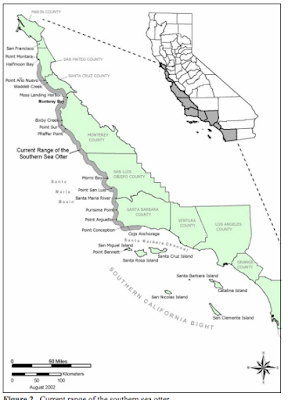| source: http://lpfw.org/wp-content/uploads/2012/06/SaeOtterRaft.jpg |
By: Brooke McCullum
The Southern Sea Otter was listed as threatened in 1977. The Southern Sea Otter was initially listed because of the reduction in their population and concern that oil spills could further endanger the remaining habitat and population Source: (http://ecos.fws.gov/docs/recovery_plan/030403.pdf)
Description and Ecology:
The Southern Sea Otter (Enhydra Lutris nereis) is one of the two sea otter subspecies in the United States. The southern Sea Otter also known as the California Sea otter, is the “smallest species of marine mammal in North America” (source: http://ecos.fws.gov/docs/recovery_plan/030403.pdf). Along with that, sea otters are a keystone species, which means that their existence effects other species and the habitat they reside in (source: http://www.defenders.org/sea-otter/basic-facts). For example when sea otters decline in number so do the number of kelp forest and the fish that live in them which can lead to habitat degradation.
Historically sea otters had populations of more than a million however, due to hunting and environmental factors their number have declined drastically. In the 1700s and 1800s the biggest threat to the population was take. In 1911 the International Fur Seal Treaty protected Southern Sea otters from hunting. In a 2002 study listed in the recovery plan: “the population
numbers about 2,150 animals and occupies approximately 500 kilometers (300 miles) of
coastline in California” (http://ecos.fws.gov/docs/recovery_plan/030403.pdf).
The historic range of sea otters consisted of the coasts of Japan, Siberia, Alaska, British Columbia, Washington, Oregon and California. Currently the range of the southern sea otter spans from Half Moon Bay and Point Conception which is along the central and southern coast of California. (source: http://www.defenders.org/sea-otter/basic-facts).
Threats to Continued Existence:
One threat to the continued existence of the southern sea otter is “human take” which can involve hunting, and harassment of the animals. In the 1700s and the 1800s the population was nearly extinct due to hunters (source: http://www.montereybayaquarium.org/). Habitat degradation is another threat to the southern sea otters. One such habitat degradation are oil spills, which can severely endanger the otter population. (http://ecos.fws.gov/docs/recovery_plan/030403.pdf ) Sea otters do not have blubber like many marine animals do, so in order to maintain body temperature they have a very thick coat of fur. (source: http://www.montereybayaquarium.org/) The oil can interfere with the sea otter’s natural way of warming themselves which leads to the otter’s death (source:http://www.defenders.org/magazine/spring-2012/worth-defending-california-sea-otter).
Description of Recovery Plan:
The recovery plan for the southern otter consists of seven goals.
| Source: http://upload.wikimedia.org/wikipedia/commons/d/d4/Sea_otter_pair2.jpg |
The second goal is to reduce the effect of oil spills on the otter population. This is a crucial step to the southern sea otter’s survival, which is why the plan calls for reducing the risk of vessel accidents and developing an oil spill response plan.
The third goal is to reduce the amount of accidental capturing of sea otters in nets. This involves monitoring how the different capturing methods used by commercial fishing lead to the incidental take of sea otters and figuring out how to reduce or eliminate this source of mortality.
The fourth goal is to estimate the population of the southern sea otters and determine at what number the sea otters can be delisted.
The fifth goal is to evaluate the translocation efforts to evaluate the effectiveness of that method.
The sixth goal is to simply improve sea otter management techniques for captive sea otters.
And finally the seventh goal is to establish an outreach and education program.
Click here for the complete recovery plan for the southern sea otter: http://ecos.fws.gov/docs/recovery_plan/030403.pdf
Click here to watch a live feed of sea otters at the Monterey Bay Aquarium:
They're really cute so you should click the link.

No comments:
Post a Comment